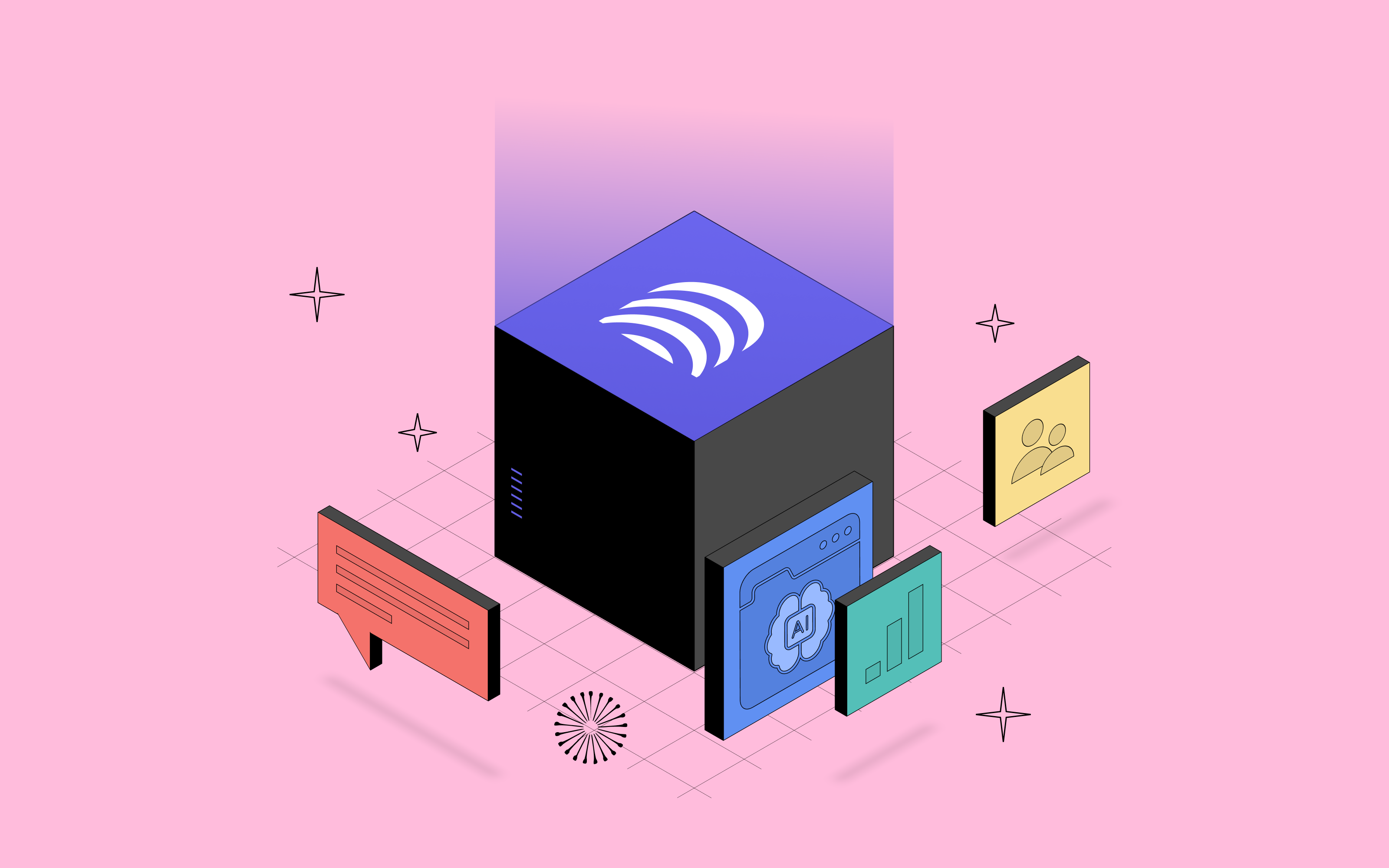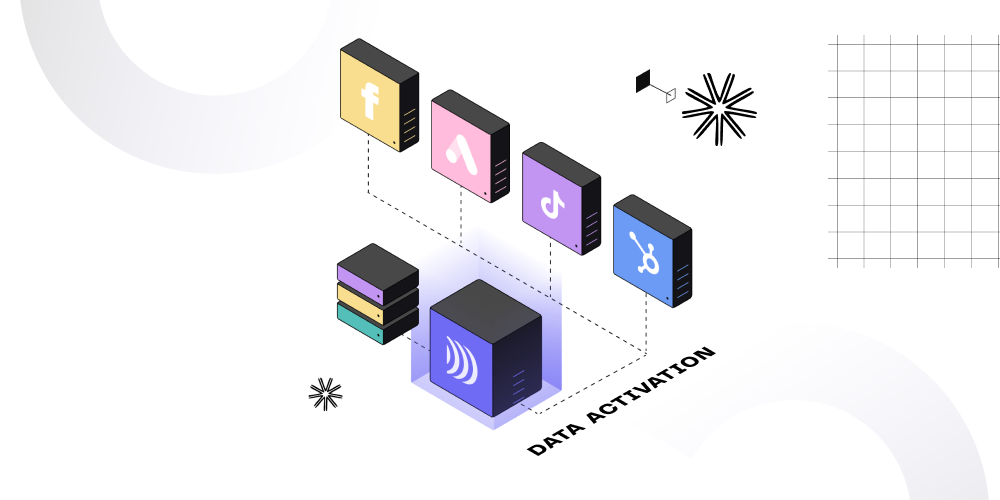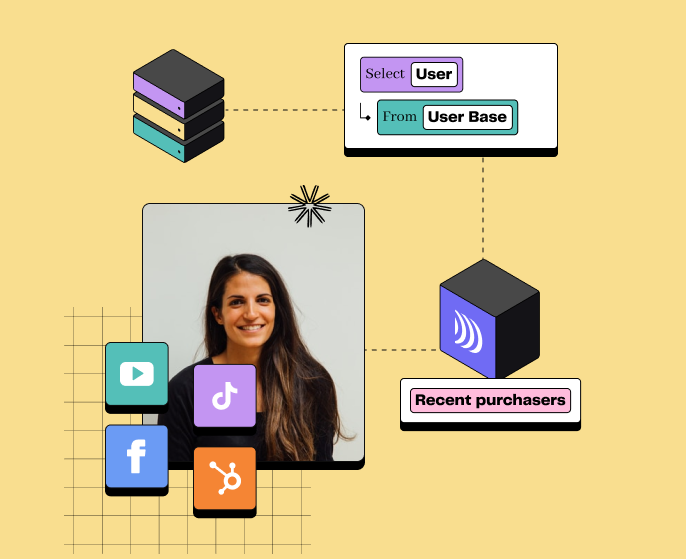
Boost your business with effective Data Activation
7min • Last updated on Jul 25, 2025

Oussama Ghanmi
Founder, CEO, and CPO
Data activation refers to the process of using customer data to trigger personalised marketing actions at the right time and through the right channel.
It involves leveraging data to understand customer preferences, buying patterns, and even product behaviours in order to engage them effectively with tailored messaging and offers.
💡 Want to discover how to unlock the power of customer data activation for better business outcomes? You're in the right place! Let's get to the heart of the matter and define what it is and why it is essential.
What is data activation?
In an era marked by rapid digital transformation, businesses are powered by increasingly complex data stacks. Although the technology infrastructure varies across industries, there is an emergence of the 'Modern Data Stack'. A set of tools built around cloud data warehouses such as Snowflake or Google BigQuery, enabling businesses to access data management solutions.
With a well-designed data management strategy, businesses can unlock the true potential of their data and fuel growth. A Modern Data Stack is typically composed of four essential components:
Data Production: The origin point of data creation, a combination of event-based and first party data, enriched by data science models qualifying customers
Data Integration: Merging data from various sources into a single, comprehensive view in the data warehouse, using ETL processes.
Data Centralisation and Refinement: Cleansing and shaping data into a digestible form, usually within a data warehouse. Data can be organised into meaningful segments like Customers, Transactions, and Product Interactions. The data warehouse serves as a centralised repository for all relevant customer information, ensuring data accuracy and accessibility for various teams across the organisation.
Data Analytics: Where data is processed, interpreted, and utilised for business intelligence.
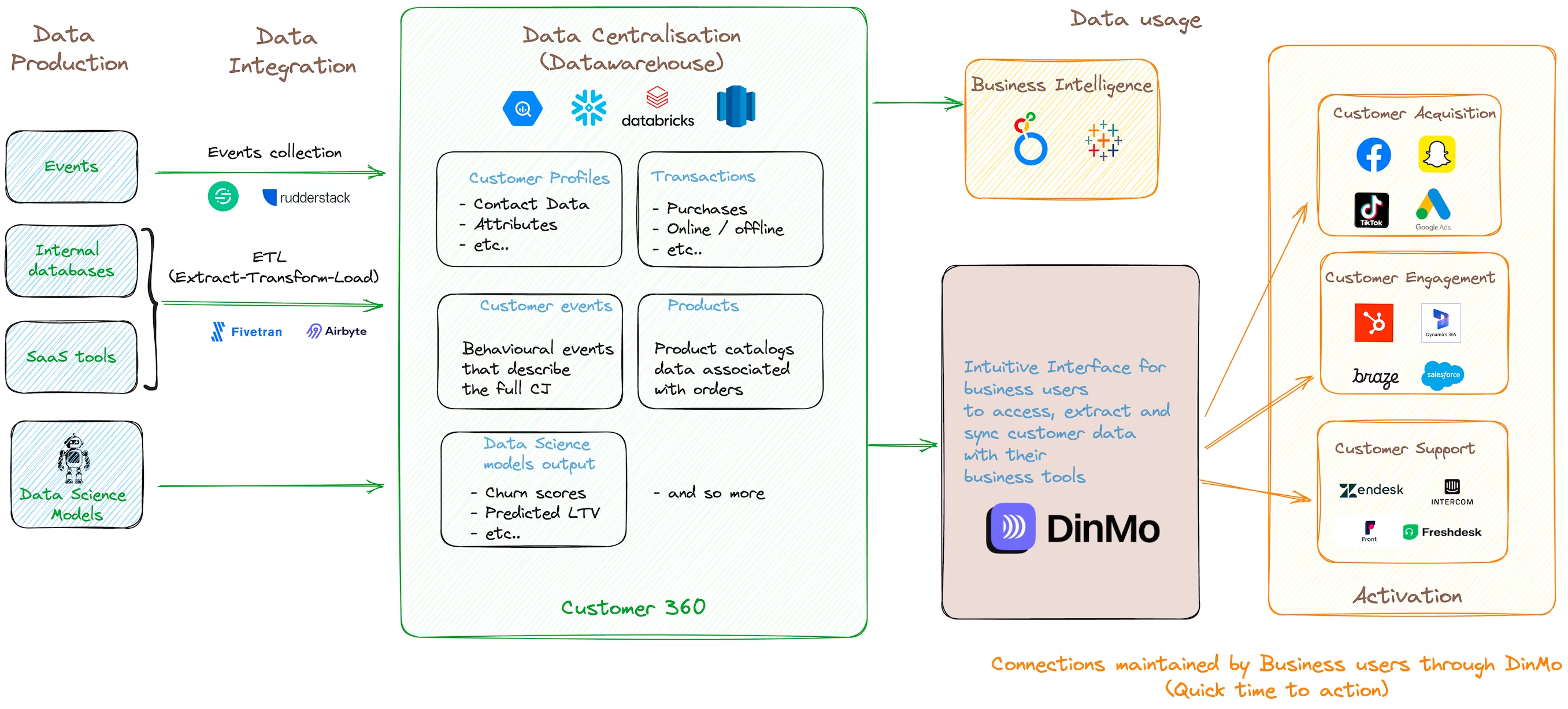
From Data Production to Data Activation
With companies relying on an average of 100 Software as a Service (SaaS) applications, data usually comes from diverse categories like web interactions, server logs, SaaS platforms, advertising services, and in-house databases. This voluminous data is then channelled into a centralised data warehouse to gain a complete understanding of the customers and their behaviour and preferences.
However, businesses face a pervasive issue: data locked away in these warehouses is often accessible only to those skilled in SQL queries. Simultaneously, dashboards and reports primarily serve the C-suite and other decision-makers, leaving a large swathe of business teams without the ability to take data-driven actions.
👉 Enter Data Activation — a paradigm shift in how everybody interacts with data, functioning as the keystone of a modern data stack.
Why data activation is a game-changer?
Data Activation takes your business from merely understanding data to acting on it. In essence, it liberates the stored knowledge in your data warehouse, making it actionable across the organisation. It becomes the bedrock for building data-centric cultures, linking analytics directly to tangible business results.
Traditionally, data warehouses are repositories for rich customer insights, including metrics like:
Recent sign-ups
Cart abandonment rate
Annual revenue
Session durations
Interactions per visit
And many more.
It also includes calculated metrics, such as the Customer Lifetime Value (CLV) or a lead or customer scoring model.
Having these insights but not making them actionable is like having a sports car and never taking it out of the garage ! Data activation eliminates this bottleneck, streamlining the path from data to decision-making and empowering marketing teams to improve every stage of the customer journey.
The technical challenges and solutions
Data activation is not a new concept and companies have been trying to move their first-party and third-party data into their operational tools for years. Yet, transferring data from a data warehouse into business applications is a daunting task. In the past, this required costly engineering resources to build custom APIs and data pipelines — a complex process that is neither scalable nor sustainable.
Customer Data Platforms (CDPs) were one of the first technologies attempting to solve this problem. They provided seamless integration of data from various sources, enabling businesses to build comprehensive customer profiles and gain a deep understanding of their preferences and behaviours.
This wealth of information could be used to create tailored marketing approaches and cultivate customer loyalty. Yet, traditional CDPs created an additional 'data truth' layer, apart from the original data warehouse. This is a problematic situation, especially for industries governed by stringent data privacy regulations.
iPaaS tools, another alternative to Reverse ETL, also fell short, offering only point-to-point data transfers with intricate workflows. iPaaS tools are not designed for large data volumes and can become extremely costly if used at scale.
👉🏼 We've listed all the solutions that enable you to activate customer data, with their pros and cons.
Reverse ETL as the catalyst for data activation
Unlike other tools that claim to enable Data Activation, Reverse ETL stands out as the most straightforward and effective solution. It acts as a seamless conduit between your data warehouse and various business tools, whether they be for sales, marketing, or customer service. By simplifying the data mapping process, Reverse ETL accelerates "time-to-value," offering more extensive data accessibility.
The combination of cloud solutions such as a data warehouse and Reverse ETL form Composable CDPs. They denote a collection of interconnected technologies that facilitate the consolidation of data from diverse marketing sources, the creation of prospect and customer segments, and their subsequent activation by marketers. Check our dedicated resource to see all the requirements for data activation.

Data Activation
Practical use cases
Data activation makes it possible to send the right message, to the right person, at the right time, on the right marketing channel. It's all about getting the right information to take the right action thanks to comprehensive customer data.
There are many use cases that Data Activation can solve. By harnessing the power of data, businesses can leverage valuable insights to optimise marketing strategies and drive sales. Customer data can be transformed into actionable insights, allowing for targeted marketing campaigns and personalised customer experiences. Here are some key benefits of data activation:
Empowering Marketing Teams
Traditional marketing metrics like Customer Acquisition Cost (CAC) and Cost Per Impression (CPI) are essential but not exhaustive. Data activation allows marketers to go beyond these metrics by syncing dynamically updated customer data from the warehouse to ad platforms.
💡 Advertising is one of the largest use cases for data activation. Marketing teams frequently request access to audience segments to upload and use for retargeting, lookalike or exclusion strategies. Marketing teams no longer need to go to the data team every time they want to experiment with a new target audience. This gives them the agility to create more personalised and effective campaigns on multiple platforms.
Moreover, enriched conversion events can be sent to ad platforms to increase match rates. This conversion data can bridge the gap between online ads and real-world events, painting a complete picture of the customer journey.
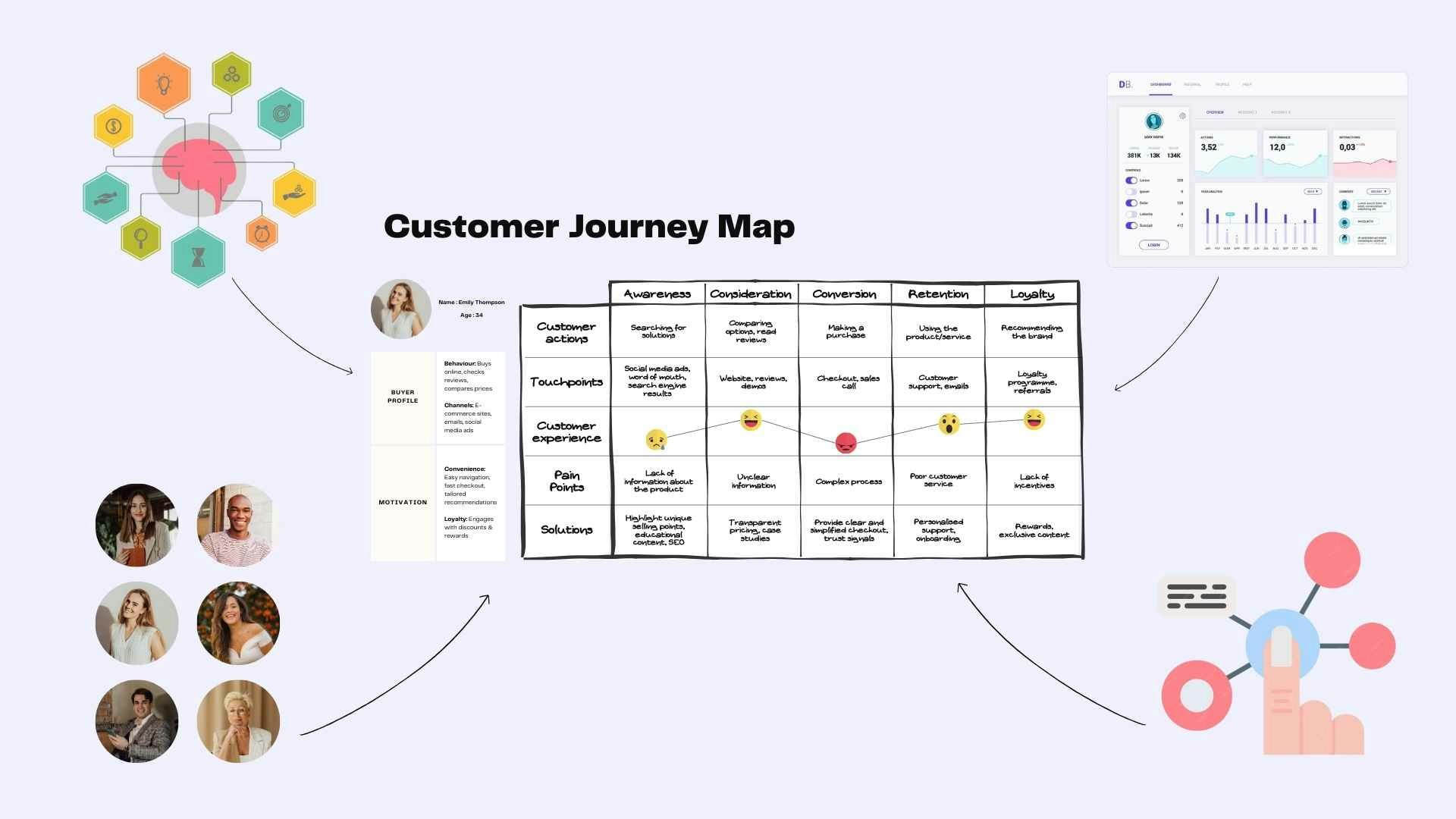
Insights for creating a Customer Journey Map
Marketing and media strategies can be more targeted and efficient, boosting the Return on Ad Spend (ROAS).
Generally speaking, better customer knowledge leads to a better user experience across all channels. The ultimate goal is to offer a complete, seamless omnichannel experience to everyone by leveraging data effectively.
👇
With data activation, marketers can ensure that all of their customer audiences are up-to-date and consistent across all their tools to improve performance. With enriched profiles, hyper-personalised experiences and unique touchpoints can be created for every customer.
Sales Enablement
For sales teams, context is king. Yet, essential information may not natively exist in their tools.
Data Activation, powered by Reverse ETL, offers a 360-degree view of each customer's journey. You may want to sync key attributes, product affinity, behaviour or modelled data from your data warehouse. This comprehensive data can sync directly to CRMs like Salesforce or HubSpot, empowering sales teams with real-time insights on your customers that can be instantly acted upon, transforming their cross selling or up selling opportunities into reality.
Enhancing Customer Support
In customer support, the timely availability of data can make or break the customer experience. Depending on the number of tickets submitted, it can quickly become impossible to address every customer. Prioritisation is key, but here again, context is king.
Data Activation empowers customer support teams to receive automated, real-time updates from the data warehouse directly into ticketing systems, thereby enhancing efficiency and customer satisfaction. Reps can prioritise and route support tickets based on customer activity, lifetime value (CLV), and other criteria. This data-driven approach ensures that the right support is provided to the right customers at the right time.
Relieving data teams
From a data team perspective, the main value of data activation depends on the automation and reliability of moving data out of the warehouse. With tools like Reverse ETL, teams can easily activate data from the warehouse and use it for marketing purposes. Reverse ETL doesn't store any data: it simply reads from your warehouse and writes to your marketing destinations.
For data teams, Reverse ETL tools are essentially "set it and forget it": once the implementation is done, there's nothing left for them to do. They don't need to waste time building and maintaining data pipelines or writing SQL queries. Instead, they can delegate data ownership to marketing, sales, or support teams and let them work on their own.
A Composable CDP empowers business teams with the ability to perform more actions on their own, such as customer segmentation, one-click data activation, measurement, and iteration. By utilising this platform, businesses can gain valuable insights and make data-driven decisions in real time. This modern stack allows for efficient data processing and management, ensuring that teams have access to the right data at the right time.
The Future of Data Activation
As Data Activation gains traction, it's crucial to choose a platform that offers flexibility, scalability, and a wide variety of integrations. Look for a Data Activation Platform that enables you to work with different types of data objects, events, and notifications while also facilitating file uploads and task management.
👉🏼 Consult our step-by-step guide to data activation to learn more about this subject.
The emergence of AI in data-driven marketing
The "new" integration of Artificial Intelligence (AI) into marketing practices now offers numerous benefits, from predicting customer behaviour and personalising customer relationships to removing technical barriers to data activation.
Indeed, machine learning technologies enable the automation of processes that, while not strictly repetitive, previously required human intervention (CSV uploads, configuration of data pipelines, set up of Reverse ETL tools, etc.). AI helps optimise all marketing activities (budget spend, customer support, content, etc.) and makes data activation even more efficient.
Get Started Today
In conclusion, data activation is a critical component of modern business strategies. By using advanced data platforms and tools, businesses can unlock valuable insights and deliver personalised experiences to their customers. With the right data management approach and efficient activation processes, organisations can stay ahead of the competition and drive success in today's data-driven world.
Our Composable CDP offers a straightforward and efficient approach to Data Activation. Leverage your existing data models, with over 50 different integrations available, and a visual audience builder designed for non-technical users.
Starting your journey towards Data Activation has never been easier or more accessible !
Empower your organisation to turn data into actionable insights today. After all, in a data-driven world, activating your data is not just an option—it's a necessity.
👀 Want to see how a data activation platform can transform your operations? Get a sneak peek from one of our experts to see how we can help your marketing team sync data to all your business tools, without any code.


















